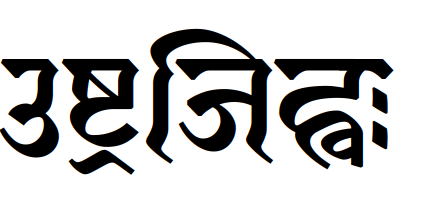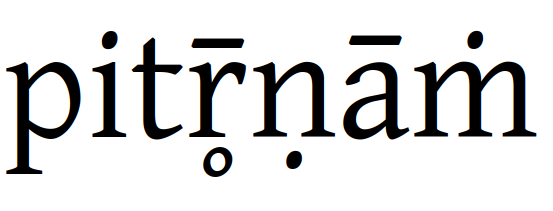
upāyāḥ
resources

This is a collection of resources to help you get started with Sanskrit.
Reference Works
- Whitney, William Dwight. A Sanskrit Grammar. Leipzig: Brietkopf and Härtel, 1896. [Internet Archive, Wikisource; WorldCat]
- The most comprehensive grammar in English, which focuses especially on the Vedic phase of the language. Whitney was rather disparaging of the “native grammarians” (and the modern scholars who followed them), so you will have to look elsewhere (like Kale or Müller) if you more are interested in the language described by Pāṇini.
- Whitney, William Dwight. The Roots, Verb-forms, and Primary Derivatives of the Sanskrit Language: A Supplement to His Sanskrit Grammar. Leipzig: Breitkopft and Härtel, 1885. [WorldCat, Internet Archive, and searchable on the Sanskrit Library and Cologne Digital Sanskrit Dictionaries.]
- A listing of all of the verbal roots of Sanskrit and which forms are made from them, classified according to their attestation. Extremely useful.
- Macdonell, Arthur Anthony. A Sanskrit Grammar for Students. Oxford: Oxford University Press, 1911. [Internet Archive.]
- This is a revised version of his abridgement of Max Müller’s grammar (see below). It is probably the most practical grammar, and the easiest to navigate and consult.
- Gonda, Jan. A Concise Elementary Grammar of the Sanskrit Language, with Exercises, Reading Selections, and a Glossary. University, Ala.: University of Alabama Press, 1968 [1966]. [Internet Archive] [A translation by Gordon B. Ford, Jr. of Gonda’s Kurze Elementar-Grammatik der Sanskrit–Sprache, Leiden 1943.]
- An extremely useful grammar.
- Kale, Moreshwar Ramchandra. A Higher Sanskrit Grammar. Delhi: Motilal Banarsidas, 1961, [Internet Archive, browseable page images at Cologne Digital Sanskrit Dictionaries.]
- A detailed list of paradigms, covering almost all of the forms you are likely to encounter. References to Pāṇini’s sūtras are given, but not consistently.
- Müller, Max. A Sanskrit Grammar for Beginners. Revised and abridged by Arthur Anthony Macdonell. London: Longmans, 1886. [Internet Archive.]
- Müller, Max. A Sanskrit Grammar for Beginners. London: Longman’s, Green, and Co., 1870. [Internet Archive.]
- This is my favorite grammar. Müller tried to follow the “native grammarians” as closely as possible. Hence this book is somewhat like the Kāśikā-vr̥ttī in the guise of a European reference grammar. It has some idiosyncracies and redundancies, but it offers very detailed rules on matters that other authors leave to memorization.
- Bucknell, Roderick. Sanskrit Manual: A quick-reference guide to the phonology and grammar of Classical Sanskrit. Delhi: Motilal Banarsidass, 2000 [1994]. [Internet Archive.]
- Speijer, Jakob S. Sanskrit Syntax. Leiden: Brill, 1886. [Internet Archive.]
- The only book of its kind (in English: see Delbrück’s book below). It badly needs updating — it was written at a time when “syntax” basically meant case usages — but it remains somewhat useful.
- Apte Vaman Shivaram. The Student’s Guide to Sanskrit Composition. Girgaon: The Standard Publishing Company, 1925. [Internet Archive.]
- Basically a reference for Sanskrit syntax, but designed to be a progressive composition textbook, with exercises.
- Wackernagel, Jakob, ed. Altindische Grammatik.
- The most detailed Sanskrit grammar available, although unfortunately never finished: the completed volumes cover phonology, morphology of the noun, and nominal derivation.
- Band I: Lautlehre. Göttingen: Vandenhoeck & Ruprecht, 1896. [Internet Archive.]
- Band II.1: Einleitung zur Wortlehre, Nominalkomposition. Göttingen: Vandenhoeck & Ruprecht, 1957. [Internet Archive.]
- Band II.2: Die Nominalsuffixe. By Albert Debrunner. Göttingen: Vandenhoeck & Ruprecht, 1954. [Internet Archive.]
- Register zur Altindischen Grammatik, by Richard Hauschild. Göttingen: Vandenhoeck & Ruprecht, 1964. [Internet Archive.]
- Delbrück, Berthold. Altindische Syntax. Halle: Waisenhaus, 1888. [GRETIL e-Library.]
- Mayrhofer, Manfred. A Sanskrit Grammar. Translated by Gordon B. Ford. University, Alabama: The University of Alabama Press, 1964.
- A grammar intended for those with an interest in comparative and historical linguistics. This is a translation of: Mayrhofer, Manfred. Sanskrit-Grammatik. Berlin: De Gruyter, 1978. [Amazon.]
- Burrow, Thomas. The Sanskrit Language. London: Faber and Faber, 1973. [Internet Archive.]
- Like Mayrhofer’s grammar, it focuses on comparative and historical linguistics.
- Wiese, Harald. Sanskrit as an Indo-European Language. Heidelberg: Heidelberg Asian Studies Publishing, 2023. [Publisher website (Open Access).]
- Renou, Louis. Histoire de la langue sanskrite. Lyon: IAC, 1956.
- Macdonell, Arthur Anthony. A Vedic Grammar for Students. Oxford: The Clarendon Press, 1916. [GRETIL e-Library.]
- Tubb, Gary, and Emery Boose. Scholastic Sanskrit. A Manual for Students. New York: Columbia University Press, 2007. [Publisher’s website.]
- Essential for intermediate to advanced students. Note that the index of the published version has some mistakes. Please use the corrected index instead.
- Werba, Chlodwig. Verba Indo-Arica. Vienna: Österreichische Akademie der Wissenschaften, 1997.
- More comprehensive than Whitney’s Roots, although rather difficult to use.
Traditional grammar (vyākaraṇam)
Here are a few resources from the South Asian tradition of linguistic analysis (vyākaraṇam). This is not meant to be an exhaustive list, nor an introduction to this tradition. Depending on your interest and background, however, you may find these resources helpful. (See also Abhyankar’s Dictionary of Sanskrit Grammar and Renou’s Terminologie Grammaticale du Sanskrit.
- Pāṇini’s Aṣṭādhyāyī (Eight Chapters): The major work of Sanskrit grammar, from about the 4th c. BCE.
- The Pāṇini Research Tool at sanskritdictionary.com is a very useful and convenient resource: it allows you to search by sūtra numbers and words, and collates a number of translations and commentaries (including Katre and Vasu, with the text of the Mahābhāṣyaḥ, the Kāśikā, etc.). I use this all the time.
- S. M. Katre’s English translation of 1987 (available on Internet Archive includes a Romanized and accented text, which is extremely useful.
- S. D. Joshi and J. A. F. Roodbergen started translating the entire Aṣṭādhyāyī into English, with detailed notes and discussion, and completed a number of volumes, some of which are available on Internet Archive.
- Otto Boehtlingk’s pioneering edition of 1887 (available on Internet Archive includes a German translation, an index of the words used by Pāṇini, and the Gaṇapāṭhaḥ.
- Srisa Chandra Vasu’s multivolume translation in the late 19th century (individual volumes on Internet Archive) was the earliest (I believe) translation into English, and is still useful.
- G. V. Devasthali’s Anubandhas of Pāṇini (Internet Archive) lists all of the diacritical sounds (anubandhas) used by Pāṇini and explains their significance, with several useful indices.
- George Cardona’s Pāṇini: His Work and Its Traditions (Internet Archive) is a good introduction to the Pāṇinian tradition. He also wrote a Survey of Research (Internet Archive) that aims to provide a bibliographic overview of work on traditional Sanskrit grammar.
- Patañjali’s Vyākaraṇamahābhāṣyaḥ (Big Commentary on Grammar):
- S. D. Joshi and J. A. F. Roodbergen translated portions of this work, including the initial lecture (Paspaśāhnikaḥ) and the section on bahuvrīhi compounds. These volumes are available on Internet Archive.
- Franz Kielhorn completed the first edition of the text in 1892 (available on Internet Archive) and the text, input by George Cardona, is available in multiple formats on GRETIL.
- Vāmana and Jayāditya’s Kāśikā Vr̥ttiḥ (The Kāśī Commentary): The most accessible commentary on Pāṇini’s Aṣṭādhyāyī, which rephrases every sūtra, and provides examples.
- A searchable text is available on GRETIL.
- The indic-dict project provides several offline texts in StarDict/Babylon format, including the commentary of Jinēndrabuddhiḥ (the Nyāsaḥ).
- Bhaṭṭōji Dīkṣita’s Siddhāntakaumudiḥ (Moonlight of the System): This was probably the most popular way of learning Sanskrit grammar from the time of its composition (17th c.) until the later 19th century. It rearranges the sūtras of Pāṇini in a topical way.
- The text is available for GoldenDict on the indic-dict project.
- Srisa Chandra Vasu produced an English translation that is available on Internet Archive.
- Varadarāja’s Laghusiddhāntakaumudiḥ (Brief Moonlight of the System): An abbreviated version of Bhaṭṭōji Dīkṣita’s primer.
- A searchable text is available on GRETIL.
- A text for GoldenDict is available on the indic-dict project.
- Sāyaṇa’s Mādhavīyadhātuvr̥ttiḥ (Commentary on Mādhava’s List of Verbal Roots): The most authoritative collection of verbal roots (dhātuḥ), produced around the 13th century.
- Dwarikadas Shastri produced an Index that is conveniently available on the Sanskrit Library website.
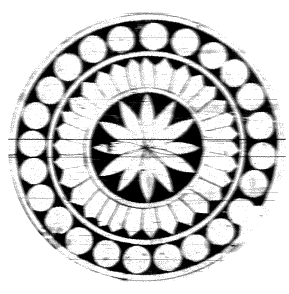
Textbooks and Readers
Textbooks
- Goldman, Robert P. and Sally J. Sutherland Goldman. Devavāṇīpraveśikā: An Introduction to the Sanskrit Language. Delhi: Motilal Banarsidass, 2011 [1980]. [Amazon.]
- This is probably the most popular Sanskrit textbook.
- Maurer, Walter Harding. The Sanskrit Language: An Introductory Grammar and Reader. Milton Park: Routledge Curzon, 2001 [1995]. [Amazon; Internet Archive.]
- Very sensibly arranged, with well-annotated readings from the Hitōpadēśaḥ and other texts. Probably what I would recommend most for self-study.
- Ruppel, Antonia M. The Cambridge Introduction to Sanskrit. Cambridge: Cambridge University Press, 2017. [Amazon.]
- The newest Sanskrit textbook. Very practical and clear.
- Deshpande, Madhav M. Saṃskr̥tasubōdhinī: A Sanskrit Primer. Ann Arbor: University of Michigan Center for South Asian Studies, 2014. [Amazon.]
- Another popular textbook, with a larger number of shorter lessons.
- Wikner, Charles. A Practical Sanskrit Introductory. [Internet Archive.]
- A short but informative overview of Sanskrit grammar, with exercises and readings.
- Aklujkar, Ashok. Sanskrit: An Easy Introduction to an Enchanting Language [Part 1A and 1B available on Internet Archive].
- Somewhat difficult to find copies of, but a detailed textbook with excellent readings.
- Coulson, Michael. Teach Yourself Sanskrit (or: Complete Sanskrit: A Teach Yourself Course). McGraw-Hill, 2011. [Amazon.]
- Recently revised by Jim Benson, this book is very detailed and at times challenging.
- Antoine, R. A Sanskrit Manual for High Schools. In two parts. Calcutta: Xavier Publication. 1968 [1953]. [Internet Archive.]
- A set of lessons which are, like Müller’s grammar, essentially the Kāśikāvr̥ttiḥ in the form of a textbook. Unfortunately marred by typos.
- Trivedî Kamalâshaṅkar Prâṇshaṅkar. The Sanskrit Teacher: Containing Interesting Sentences and Verses from Sanskrit Literature. Bombay: Macmillan, 1926. [Internet Archive: Part I, Part II.]
- This book can also be used as an elementary textbook, but its real value lies in the selection of readings in the later lessons.
- Killingley, Dermot. Beginning Sanskrit. Newcastle upon Tyne: Grevatt and Gravatt, 1996–2003. 3 vols. [Publisher’s website.]
- Perry, Edward. A Sanskrit Primer. Based on Georg Bühler’s Leitfaden für den Elementar-Cursus des Sanskrit. Boston: Ginn and Company, 1901. [Internet Archive.]
- English-speaking Sanskritists of earlier generations have traumatic memories of this book.
- Brocquet, Sylvain. Grammaire élémentaire et pratique du sanskrit classique: Avec exercices corrigés et textes expliqués. Brussels: Safran, 2010.
- I have never personally seen this book, but the extracts inspire confidence.
- Balbir, Nalini. Le Sanskrit. Chennevières-sur-Marne: Assimil, 2013. [Amazon] Comes with four audio CDs.
- Very simple and progressive lessons.
- Guhe, Eberhard. Einführung in das klassische Sanskrit. Wiesbaden: Harrassowitz, 2008.
- A huge advance on Stenzler and Bühler’s earlier German textbooks.
- Stenzler, Adolf Friedrich. Elementarbuch der Sanskrit-Sprache. Giessen: Töpelmann, 1915. [Internet Archive]
- Lambert, H. M. Introduction to the Dēvanāgarī Script, For Students of Sanskrit, Hindi, Marathi, Gujarati and Bengali. London: Oxford University Press, 1953. [Internet Archive.]
- A detailed guide to the Dēvanāgarī script, with instructions for using a nib pen (!). It uses a transliteration system whereby a is rendered as ə.
- Emeneau, Murray B. Sanskrit Sandhi and Exercises. Berkeley: University of California Press, 1958. [Internet Archive.]
- A student-friendly presentation of the Sanskrit sandhi rules, along with exercises.
Readers
See also Gonda’s Concise Elementary Grammar, which contains selections from the Vētālapañcaviṁśatī, the Pañcatantraḥ and Hitōpadēśaḥ, and the Rāmāyaṇam and Mahābhārataḥ, with a glossary.
- Lanman, Charles Rockwell. 1963. A Sanskrit Reader: Text and Vocabulary and Notes. Cambridge, Massachusetts: Harvard University Press. [Internet Archive.]
- One of the most popular readers for intermediate students.
- Liebich, Bruno. 1905. Sanskrit-Lesebuch. Leipzig: Harrassowitz. [Google Books.]
- Intended for German students, but provides a text (in transliteration) along with a translation (usually in English) from a selection of different texts.
- Scharf, Peter. 2003. Rāmopākhyāna: The Story of Rāma in the Mahābhārata: An Independent Study-Reader in Sanskrit. London: RoutledgeCurzon. [Worldcat.]
- Complete grammatical annotations for the portion of the Rāma story contained in the Mahābhārata.
- Gaṇapati Śāstrī, T. 1907. Prathamā Pāṭhāvalī. Trivandrum: Bhaskara Press. [Internet Archive.]
- Simple readings in Sanskrit, with a vocabulary.
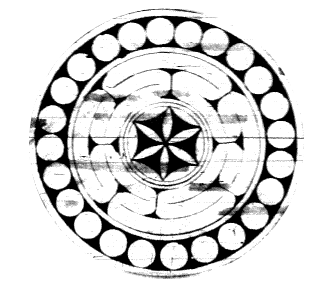
Dictionaries
Overview
These are the dictionaries you are most likely to use in your study of Sanskrit. I have included a few links where relevant, but for further instructions on how to use these dictionaries, see the section below.
Note: Most of the sample images are from the Cologne Digital Sanskrit Dictionaries website.
Sanskrit–English Dictionaries
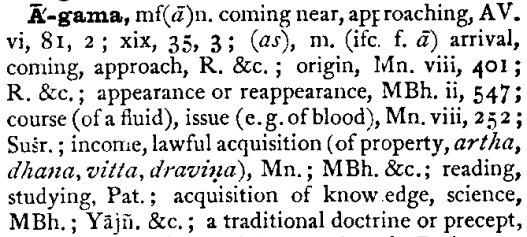
Monier-Williams
Monier Monier-Williams. A Sanskrit–English Dictionary. Oxford: The Clarendon Press, 1899.
This is the Sanskrit–English dictionary of reference, in spite of (or rather because of) the fact that Monier Williams took many entries without acknowledgement from the Petersburger Wörterbuch (see below). Its entries are arranged more or less historically (i.e., the oldest meanings and attestations are listed first), and forms that are attested with accents are given in their accented form.
indic-dict project; aupasana.com; Arsha Drishti; scans available on Internet Archive
Cologne; Gandhari.org; Sanskrit Library; kosha.sanskrit.today

Apte
Vaman Shivaram Apte. The Practical Sanskrit–English Dictionary. Poona: Prasad Prakashan, 1957–1959. 3 vols.
This dictionary generally has a wider range of meanings than Monier-Williams, especially for the first half of the alphabet, but the order of definitions in each entry seems rather haphazard (the most common meaning often occuring somewhere toward the middle or end of the entry). It sometimes contains useful notes on the derivation of words, and the dictionary contains essential appendices on Sanskrit meters and Sanskrit maxims (nyāyāḥ).
indic-dict project; aupasana.com; Arsha Drishti; scans available on Internet Archive
Cologne; sanskritdictionary.com; DSAL; Sanskrit Library; kosha.sanskrit.today

Edgerton
Franklin Edgerton. Buddhist Hybrid Sanskrit Grammar and Dictionary: Vol. II: Dictionary. New Haven: Yale University Press, 1953.
This dictionary was compiled mainly for “Buddhist Hybrid Sanskrit,” i.e., the Sanskrit heavily influenced by Middle Indic that appears in early Buddhist works like the Lalitavistara and Mahāvastu, but it is especially valuable for its coverage of Buddhist technical terms and obscure vocabulary that does not appear in the principal Sanskrit dictionaries. Edgerton often refers to Pali and Tibetan equivalents.
indic-dict project; Simone Wiles; scans available on Internet Archive
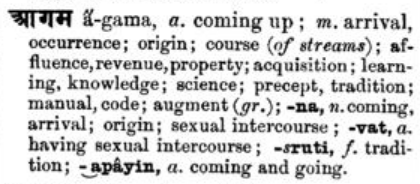
Macdonell
Arthur Anthony Macdonell. A Practical Sanskrit Dictionary. London: Oxford University Press, 1929.
A reasonably comprehensive dictionary, with entries in transliteration, and occasional historical and comparative notes (given only seldom in Monier-Williams).
indic-dict project; scans available at Internet Archive
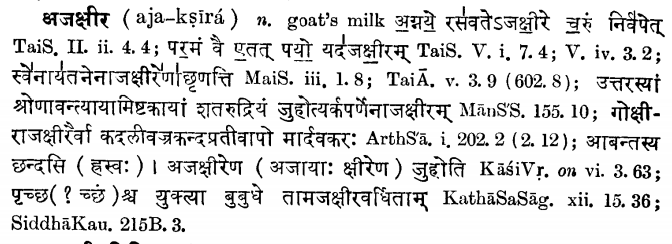
EDSHP
A. M. Ghatage. Encyclopaedic Dictionary of Sanskrit on Historical Principles. Poona: Deccan College Post-Graduate and Research Institute, 1977–2008.
This project, begun by the late A. M. Ghatage, endeavored to document a vast swathe of Sanskrit usage, and to arrange the entries in terms of the occurrence of each word. It has by far the largest number of references of any dictionary available, but it has progressed very slowly, and to my knowledge it is not available in electronic form.
English–Sanskrit Dictionaries
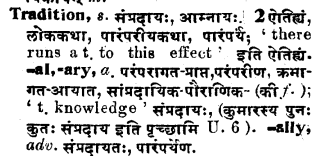
Apte
Vaman Shivaram Apte. The Student’s English–Sanskrit Dictionary. Poona: Arya Bhushana Press, 1884.
Probably the best English–Sanskrit dictionary, giving the most common Sanskrit expressions for given English words, roughly in order of their frequency of occurrence, and often with illustrative sentences. Recommended for any Sanskrit composition assignments.
indic-dict project; scans available on Internet Archive
Sanskrit–Sanskrit Dictionaries
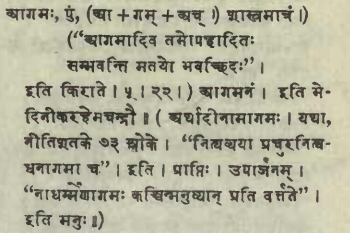
Śabdakalpadrumaḥ
Raja Radha Kanta Deva. Shabda-Kalpadrum. Calcutta: Barada Prasad Basu and Hari Charan Basu, 1886.
According to the title page, “an encyclopedic dictionary of Sanskrit words arranged in alphabetical order giving the etymological origin of the words according to Panini, their gender, various meanings and synonyms, and illustrating their syntactical usage and connotation with quotations drawn from various authoritative sources such as Vedas, Vedanta, Nyaya, other Darshanas, Puranas, music, art, astronomy tantra, rhetorics and prosody and medicine etc.”
indic-dict project; aupasana.com; Arsha Drishti; scans available on Internet Archive
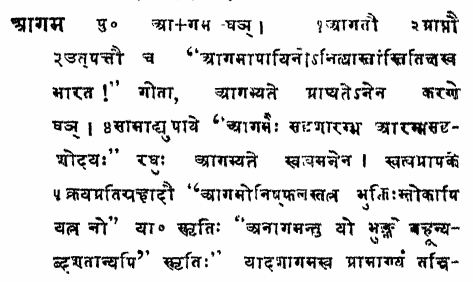
Vācaspatyam
Śrītāranātha-Tarkavācaspati-Bhaṭṭācārya. Vācaspatyam (Br̥hat Saṁskr̥tābhidhānam). Vārāṇasī: Caukhambā Saṁskr̥ta Sīrija Āphisa, 1873.
This is perhaps the most comprehensive Sanskrit dictionary, with abundant citations, and detailed comments on the derivation of all nominal forms.
indic-dict project; aupasana.com; Arsha Drishti; scans available on Internet Archive
German–Sanskrit Dictionaries
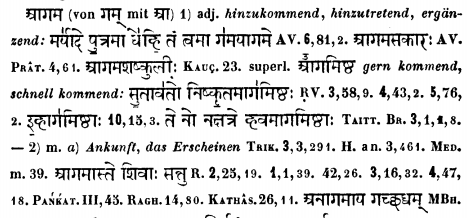
Grosses Petersburger Wörterbuch
Otto Böhtlingk and Rudolf Roth. Sanskrit Wörterbuch (Grosses Petersburger Wörterbuch). St. Petersburg: Eggers, 1855–1895.
This seven-volume dictionary is among the most exhaustive in any European language, and includes references (unlike the “short” version below).
indic-dict project
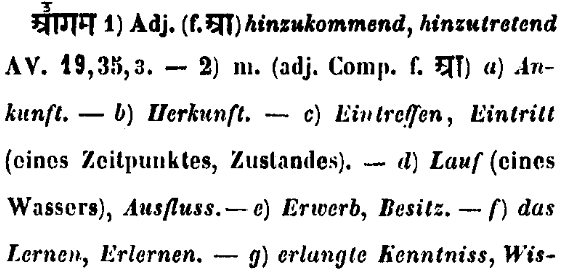
(Kürzeres) Petersburger Wörterbuch
Otto Böhtlingk and Rudolf Roth. Sanskrit-Wörterbuch in kürzerer Fassung. St. Petersburg: Eggers, 1879–1889.
The Petersburg-Wörterbuch, but without references.
indic-dict project
Comparative Dictionaries
Turner (CDIAL)
Ralph Lilley Turner. A Comparative Dictionary of Indo-Aryan Languages. London: Oxford University Press, 1962–1966.
The headwords are in Sanskrit (or reconstructed Old Indic), and the entries trace their appearance through Middle Indic (including Pali, Ardhamagadhi and Prakrit) and in the modern Indic languages (including Hindi, Bengali, Marathi, and so on).
DSAL (includes all the published supplements); Sanskrit Library
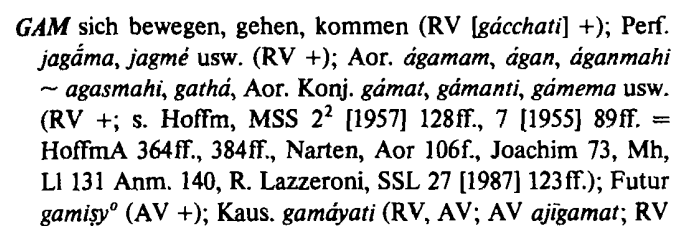
EWA
Manfred Mayrhofer. Etymologisches Wörterbuch des Altindoarischen. Heidelberg: Carl Winter, 1992–2001. 3 volumes.
A revised and expanded version of the following (to which it often refers). Now the most authoritative historical dictionary of Sanskrit.

KEWA
Manfred Mayrhofer. Kurzgefasstes etymologisches Wörterbuch des Altindischen. Heidelberg: Carl Winter, 1976. 4 volumes.
A “short” etymological dictionary, which has been superceded by the later, larger dictionary (see below). But unlike the later dictionary, this one presents definitions in both German and English.
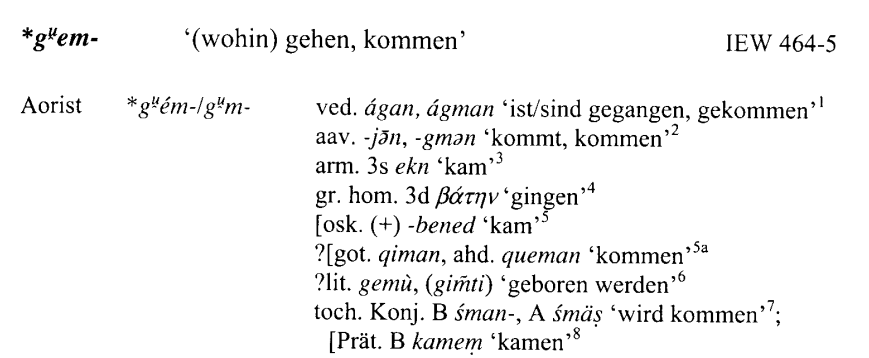
LIV
Helmut Rix et al. Lexicon der indogermanischen Verben. Wiesbaden: Reichert, 2001. Second edition.
The standard reference for Indo-European verbs, and contains detailed information about the verbal forms of early (Vedic) Sanskrit.

DED
Thomas Burrow and Murray B. Emeneau. A Dravidian Etymological Dictionary. 2nd edition. Oxford: Clarendon Press, 1984.
This is primarily a dictionary of the Dravidian languages (Tamil, Malayalam, Kannada, Tulu, Telugu, etc.), but it often refers to Sanskrit words, either when they are borrowed into the Dravidian languages or when Dravidian words are borrowed into Sanskrit.
scans available on Internet Archive
Specialized Dictionaries
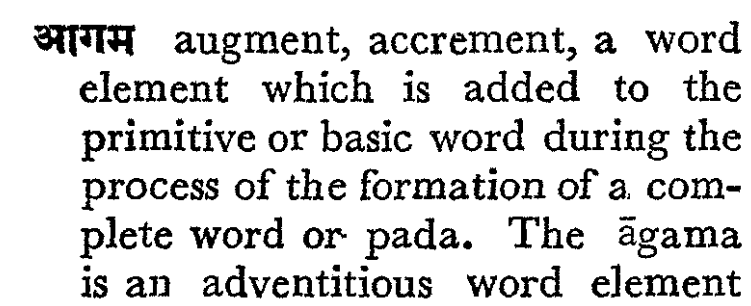
Abhyankar
Kashinath Vasudev Abhyankar. A Dictionary of Sanskrit Grammar. Baroda: Oriental Institute, 1961.
Defines most of the technical terms used in Sanskrit grammar. This is useful for a general overview, although you should consult other reference works for full details and references.
indic-dict project; page scans on Internet Archive

Renou
Louis Renou. Terminologie Grammaticale du Sanskrit. Paris: Librairie Ancienne Honoré Champion, 1957.
Definitions of the technical terms used in the tradition of Sanskrit grammar, including the work of Pāṇini, the Prātiśākhyas, Bhartr̥hari, etc.
page scans at Internet Archive

Sircar
D. C. Sircar Indian Epigraphical Glossary. Delhi: Motilal Banarsidass, 1966.
This is a glossary of terms found in Indian inscriptions, primarily Sanskrit, Middle Indic, and Tamil. It is especially useful for terms that are attested in inscriptions but are rarely attested in literary texts and not found in other dictionaries. It also contains more detailed information on historical realia than most of the nineteenth-century dictionaries.
indic-dict project; scans available at Internet Archive
Oguibénine
Boris Oguibénine. Materials for the Lexicography of Buddhist Sanskrit.
Provides addenda to Edgerton’s dictionary and further references.
Using dictionaries
Nowadays you have three options: use a printed dictionary, use an offline dictionary on a computer or mobile device, or use an online dictionary. For a relatively comprehensive list of the dictionary tools available now, see the Sanskrit Documents website.
For an explanation of how to navigate and fruitfully use the Monier-Williams dictionary, please consult Wikner’s Practical Sanskrit Introductory, which dedicates several lessons to the subject.
Printed dictionaries
Pretty self-explanatory. You can find reprints of most of the dictionaries mentioned above wherever Indological books are sold.
Offline dictionaries
These are downloadable files, most often in formats like Babylon (.bgl, .gls) and Stardict (.ifo, .dict, .idx, .syn). I use GoldenDict (developer website; source code on GitHub; SourceForge). Good instructions are also available at these websites: Introductory Sanskrit (Guy Leavitt); Arsha Drishti (Advayatmananda Saraswati); Aupasana.com (Ajit Krishnan); Digital Tibetan (Dominik Schlösser).
Getting set up with GoldenDict
- Install the GoldenDict program.
- Linux: The package
goldendictis probably available in your OS repository (e.g.,sudo apt-get install goldendict). Otherwise you can download a package or install it from source. - Mac OS:
.dmgfiles are available from the SourceForge site. You should probably use the Early Access Builds. - Windows:
.exeinstallers are available from the SourceForge site. You should probably use the Early Access Builds. - Android: There is an Android app by the same developers as the desktop application, but the full version costs some money. Search for GoldenDict on the Google Play Store.
- iPhone: There is no GoldenDict app for iPhone, but there is a Dictionary Universal app (for some money) that reads the StarDict format.
- Linux: The package
- Download dictionary data. There are several sources, depending on what you need:
- The indic-dict repository on GitHub, maintained by Vishvas Vasuki, is the most complete collection of StarDict files for Indic languages, including Sanskrit. See the stardict-sanskrit folder for files with English headwords (M-W, Apte, Keith’s Vedic Index, Edgerton’s Buddhist Hybrid Sanskrit dictionary, Meulenbeld’s Dictionary of Plants, Sircar’s Indian Epigraphical Glossary, etc.) and Sanskrit headwords (including Śabdakalpadruma, Vācaspatyam, and the Petersburg Wörterbuch); the stardict-sanskrit-vyAkaraNa directory contains additional specialized dictionaries, including Abhyankar’s Dictionary of Sanskrit Grammar.
- Vishvas Vasuki has also created a Stardict Dictionary Updater app for Android phones, which will download and install all of the dictionary data.
- Aupasana.com has download links (Dropbox) for Apte, M-W, Amarakōśa, Śabdakalpadruma, and Vācaspatyam, as well as several grammatical texts. The same website lists the input format for searching the dictionaries, which is based on the ITRANS scheme.
- Arsha Drishti has download links (Dropbox) for Apte, M-W, Amarakōśa, Śabdakalpadruma, Vācaspatyam, and a list of declined nominal forms and conjugated verbal forms from the Sanskrit Heritage site, in addition to grammatical texts. The input format is the same as above (based on ITRANS); see the website for “Usage Notes.”
- The Sanskrit Heritage site has the Sanskrit Heritage Dictionary (Gérard Huet), as well as several additional resources, including a dictionary of inflected forms with declension tables. See “Download instructions” on that website.
- Simone Wiles has a version of Edgerton’s Buddhist Hybrid Sanskrit dictionary in StarDict and Mac Dictionary formats.
- (Tibetan dictionaries are also available: see Digital Tibetan.)
- Make sure that GoldenDict can find the dictionary data. On Android phones, this means putting them in the
GoldenDictdirectory on your SD card. On most other devices, you can tell GoldenDict where to look by going toEdit→Dictionariesor pressingF3, and specifying the directory where the program should look as follows: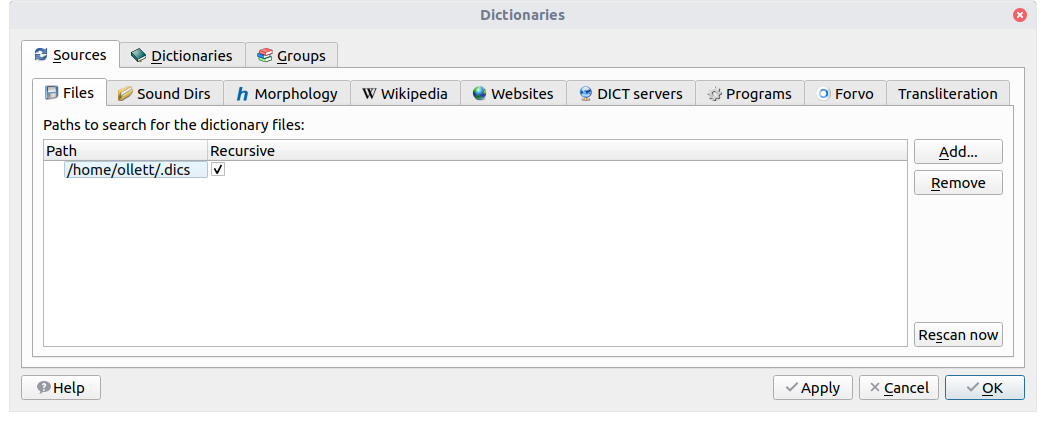
- Learn how to use the dictionaries. You can configure the dictionaries you search in GoldenDict (I have mine set up into English–Sanskrit and Sanskrit–Sanskrit groups). You can even configure how the dictionary entries are displayed using CSS. Play around with the program.
There are other options for offline dictionaries. The Digital Dictionaries of South Asia project is developing a number of mobile apps for its dictionaries (including Apte) that have offline data. The Cologne Digital Sanskrit Dictionaries webpage has almost every dictionary available for download in XML format (in SLP1 encoding).
Online dictionaries
These are websites or apps that provide interfaces to the major Sanskrit dictionaries. They differ in the dictionaries they offer, the input formats they accept, and how the output it displayed.
The Cologne Digital Sanskrit Dictionaries project offers a wide range of interfaces (headwords and full text) for most of the dictionaries described above (and more). It is a spectacular resource. The entries are searchable, with links to the scanned page images, and all of the data is downloadable as well (hence most of the other dictionary interfaces and offline dictionaries use data from this project). You can input the search terms in Harvard-Kyoto, ITRANS, or SLP1 encoding.
Digital Dictionaries of South Asia at the University of Chicago offers searchable dictionaries for a number of South Asian languages, including Sanskrit. There is now a combined Sanskrit dictionary that searches both Apte and Macdonell.
Several websites allow you to search multiple dictionaries at once. One is the Sanskrit Library’s multi-dictionary search, but the dictionaries need to be selected by changing one’s preferences. Sanskritdictionary.com also searches multiple dictionaries at once; the default is full-text search. Kosha.sanskrit.today similarly has a multi-dictionary search.
API access
You may want to pull dictionary data programmatically from a website for some reason or another (for instance, if you are making an app or website of your own). There is an increasing number of web services that return dictionary data upon requests. One very promising example comes, unsurprisingly, from the Cologne Digital Sanskrit Dictionaries project: the C-SALT APIs.
Many of the online dictionaries allow you to search by URL, which provides a “pseudo-API”: you could pull the HTML code from a web address with the entry word as a parameter.
Traditional lexicons (kōśaḥ)
There are many premodern lexicons of Sanskrit, which list synonyms for each Sanskrit word. Note that Dhaval Patel and colleagues have digitized almost every Sanskrit lexicon available in print and the texts are available in the sanskrit-kosha repository on GitHub.
- Amara’s Nāmaliṅgānuśāsanam (Teaching on the Gender of Nominals), often just called Amarakōśaḥ (Amara’s Lexicon): The earliest and most widely-used Sanskrit lexicon. It groups words by category, and lists synonyms, along with the gender of each word.
- Available for GoldenDict on the indic-dict project.
- Many copies on Internet Archive.
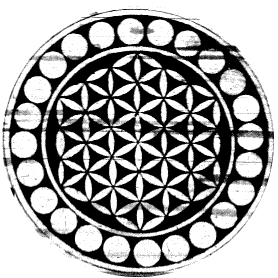
Tools
Typing
The following resources should help you get started in typing Sanskrit, either in an Indic script like Dēvanāgarī or in Roman transliteration with diacritics.
Linux (Ubuntu):
- Ubuntu’s Input Sources includes a number of Indic scripts by default. You can add keyboard layouts of your own if you like. I put together some brief instructions here.
Windows:
- You should be able to add an Indic Transliteration keyboard which is provided by Microsoft. Here is a guide to adding the phonetic keyboards.
- Microsoft has a (somewhat confusing) website that provides an “Indic Language Input Tool.”
- I have also been told that the Diacritic Hotkeys-Programme and the Diacritic Longpress-Programme made by Bhante Ānandajoti works well for Windows.
- The UBC Sanskrit site has some instructions for installing and using the Devanagari-QWERTY keyboard on Windows, which may not be necessary if the above solutions work.
Mac OS:
- You can use the built-in keyboards under System Preferences > Input Sources > Keyboard and Character Viewer. Among the options are Dēvanāgarī (and other Indic Scripts) as well as US Extended, which will allow you to add diacritics with the OPTION key.
- You can also add additional keyboard layouts:
- The EasyUnicode layout, created by Toshiya Unebe for typing in IAST, is available here. Here is a step-by-step guide for installing and using it.
- Shreevatsa has produced an alternative layout for IAST.
- You can also create your own keyboard layouts using a program called Ukelele, designed by SIL.
iPhone:
- You should just be able to install and use an Apple-supported keyboard layout for Indic scripts. See this website for instructions.
Android:
- Google Indic Keyboard (for typing in Indic scripts)
Fonts
Dēvanāgarī Fonts:
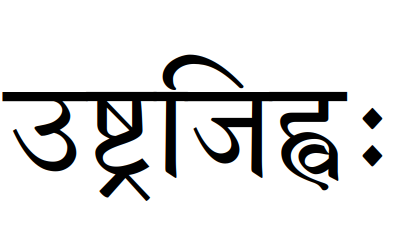
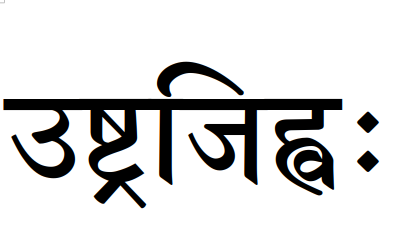
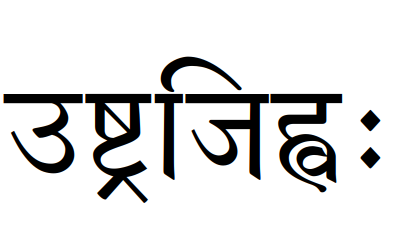
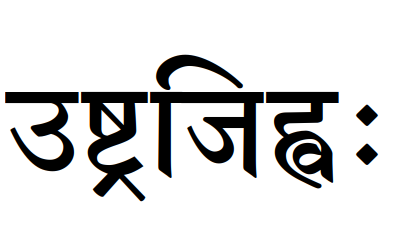
Adishila
The Adishila fonts were developed under the leadership of Krishna Prasad G. They are available for free from adishila.com. They are based on the classic typeface used at the Nirṇaya-Sāgara Press in Mumbai. The fonts support all of the ligatures necessary for Sanskrit, and uniquely among Dēvanāgarī fonts, they include an italic face and a bold face (shown here). There is also a letterpress variant, which is identical except that the characters have a break in the top line (śirōrēkhā). License: Free for commercial and non-commercial use.
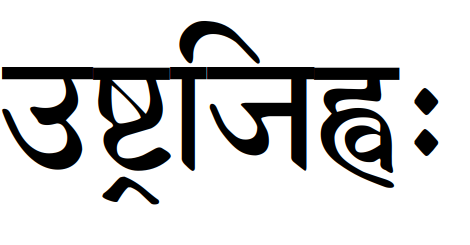
Sanskrit 2003
This font was developed by the Omkarananda Ashram and was distributed with the ITRANS software, which used to be used to input Sanskrit in Windows before modern input methods. It is available from several sources, including the Omkarananda Ashram website. License: Unknown.
Fonts for Transliteration: I strongly recommend the IndUni fonts developed by John Smith, which were purposely designed to render all of the diacritics that may be necessary for Sanskrit in transliteration, regardless of which transliteration conventions are used (IAST or ISO-15919), as well as Avestan and Chinese (in Pinyin). If you use Ubuntu, they are available in the main Ubuntu repositories as fonts-johnsmith-induni. Here is a short description of the fonts on Luc Devroye’s excellent resource on typography. This website uses the IndUni fonts.
The fonts on which the IndUni faces are based were released by URW++, a Hamburg-based foundry that released several classic fonts under the GPL license in 1999.
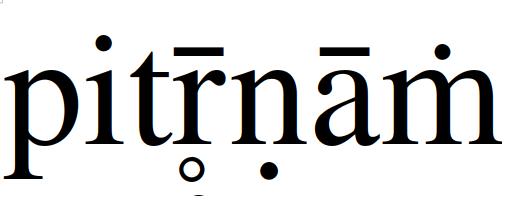
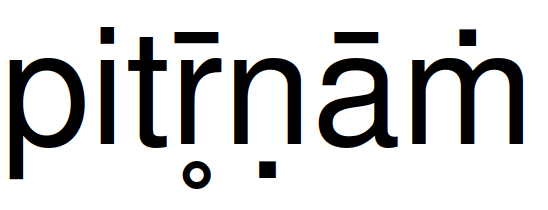
IndUni-H
Based on URW++’s Helvetica lookalike.
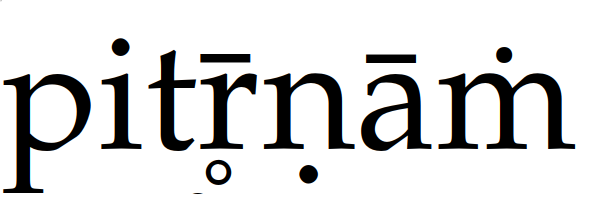
IndUni-P
Based on URW++’s Palatino lookalike.

IndUni-N
Based on URW++’s New Century Schoolbook lookalike.

IndUni-C
Based on URW++’s Courier lookalike.
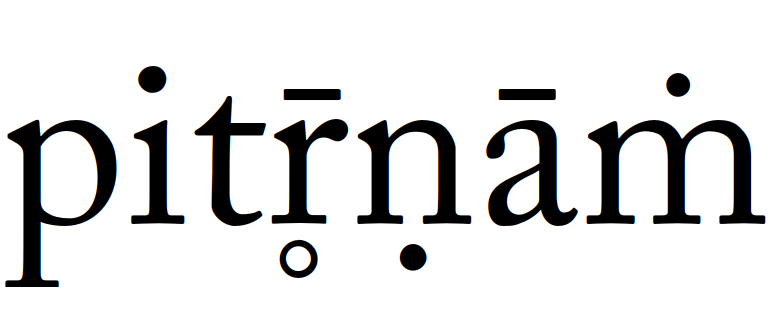
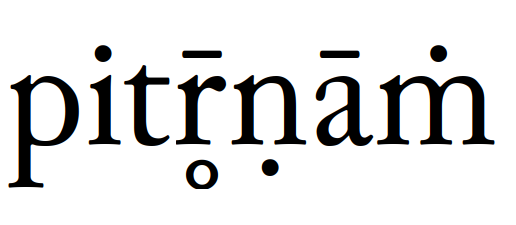
Junicode
Developed for Medievalists, with a wide range of Unicode characters. Available from the developers at SourceForge. License: Open Font License.
Transliteration
Transliteration refers to converting a text in one script (e.g., Dēvanāgarī) to another script (e.g., ISO-15919 Romanization).
- Aksharamukha is a great web-based transliteration tool.
- Sanscript is a library for transliteration (in Javascript and Python) that is great for offline and in-app use. I use it on this website.
Web Resources
- Guy Leavitt’s excellent Introductory Sanskrit website, providing the materials from the courses he taught at Columbia University.
- Sanskritdictionary.com: An aggregation of several lexical resources for Sanskrit.
- Indologica.de: An excellent list of digitized books about Sanskrit and other Indological topics.
- GRETIL E-Library: Another excellent collection of scanned books and articles.
- UBC Sanskrit: Lessons and resources designed by Adheesh Sathaye (with Tim Bellefleur).
- Digital Corpus of Sanskrit: A large and fully-tagged corpus of Sanskrit texts, with a dictionary, and other useful features, built by Oliver Hellwig.
- learnsanskrit.org: Resources compiled by Arun Prasad.
- The Sanskrit Library: A rich collection of tools and resources assembled by Peter Scharf and collaborators.
- The Sanskrit Heritage Site: Home to a useful set of tools (for generating forms, lemmatizing words, and analyzing sandhi), built by Gérard Huet.
- Saṃsādhanī: Computational tools for Sanskrit, maintained by Amba Kulkarni.
- Pañcāṅga, an Indian date calculator developed by Michio Yano.
- SALC’s list of resources.
- Tim Lubin’s list of South Asia-related links.
- A compilation of Sanskrit Tools at Arsha Drishti, including useful directory of dictionaries (including Goldendict files).
- Pāṇini Research Tool, a useful online tool for reading Pāṇini’s grammar of Sanskrit.

Flashcards
In previous versions of this course I have used Quizlet flash cards. Quizlet is a for-profit company that requires you to install their proprietary software in order to use the flashcards. I now favor Anki, which is free and open-source, and which already has a wealth of Sanskrit-related decks.
I have created a number of flashcards for this course:
- Course Vocabulary (.apkg, Google Sheet): The vocabulary assigned in the lessons in this course (364 items at the moment).
- Dēvanāgarī Practice (.apkg): Cards to help familiarize you with Dēvanāgarī, including conjunct characters.
- Top 125 Sanskrit Verbs, Romanized (ISO-15919) version (.apkg, AnkiWeb, Google Sheets): The top 100 verbs from both the Rāmāyaṇa and Mahābhārata, combined and linked to dictionaries (Monier-Williams and Apte) and lists of forms (Whitney and Huet), as well as example sentences.
- Top 125 Sanskrit Verbs, Dēvanāgarī version (.apkg, AnkiWeb, Google Sheets): The same as the above, but with Sanskrit words in Dēvanāgarī.
If you make Anki decks that would be useful to people who are learning Sanskrit, please feel free to share them with me so I can put them here. It is always useful to include any spreadsheets (or tabular data) on which the decks are based.




